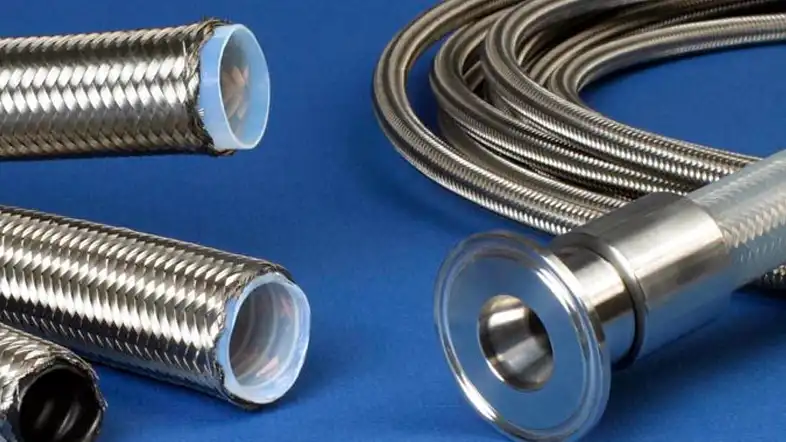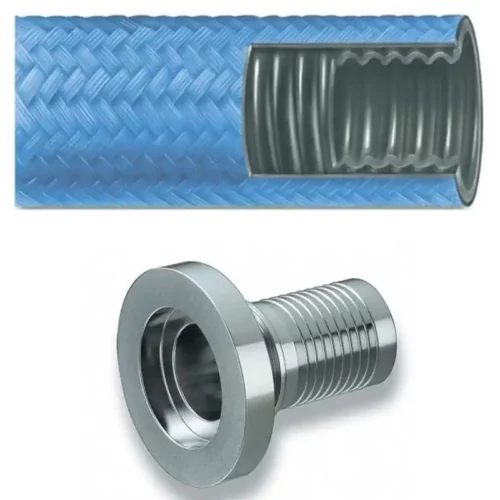In the world of industrial applications, hoses play a crucial role in ensuring the smooth flow of various substances. One such hose that has gained significant attention is the PTFE SAE 100R14 TYBE B Conductive Hose.
We will explore the features, benefits, and applications of this specialized hose-PTFE SAE 100R14 TYBE B Conductive Hose. Whether you are an industry professional or someone curious about hoses, this article will provide you with valuable insights.
What is Conductive PTFE Hose
The PTFE SAE 100R14 TYBE B Conductive Hose is a specialized type of hose designed for applications that require high levels of conductivity and resistance to chemicals. It is constructed using a smooth bore PTFE (polytetrafluoroethylene) inner tube and reinforced with multiple layers of stainless steel braids. The conductive properties of this hose are achieved through the inclusion of a conductive black PTFE liner.
A conductive PTFE hose is a hose that utilizes a PTFE liner that is also covered with a carbon coating in order to discharge static electricity. This carbon coating significantly increases the price of the hose. This hose follows standard SAE 100R14 Type B and appears black in color when you look at the liner. A typical SAE 100R14 Type A hose appears white when looking at the liner. Type A is what is sold by Hot Rod fuel hose.
A conductive PTFE hose incorporates a PTFE liner coated with carbon to effectively dissipate static electricity. The presence of this carbon coating significantly raises the price of the hose.
How Does Conductive PTFE Hose Work

Conductive PTFE (Polytetrafluoroethylene) hose is a type of hose that is specifically designed to dissipate static electricity. PTFE is a synthetic fluoropolymer known for its excellent chemical resistance and non-stick properties. Conductive PTFE hose incorporates a conductive material, such as carbon black, into the PTFE matrix to provide electrical conductivity.
The conductivity of the hose is essential in applications where static electricity buildup can occur, as it helps prevent electrical discharge that can be hazardous in certain environments. Static electricity can build up when liquids or gases flow through non-conductive materials, creating a potential risk of sparks or ignition in the presence of flammable substances.
In a conductive PTFE hose, the addition of a conductive material allows electrical charges to be conducted through the hose and discharged safely. Carbon black is commonly used as the conductive filler in PTFE hoses due to its high conductivity and compatibility with the PTFE material.
The conductive PTFE hose retains all the beneficial properties of standard PTFE hoses, including chemical resistance, high temperature resistance, low friction, and flexibility. It is commonly used in various industrial applications, such as in the chemical, pharmaceutical, and food processing industries, where static electricity control is necessary.
When using conductive PTFE hose, it is important to ensure proper grounding to effectively dissipate static charges. Grounding the hose involves connecting it to a conductive surface or a grounding point to allow the static electricity to safely discharge.
The conductive PTFE hose provides a reliable and safe solution for applications where static electricity control is critical. Its ability to dissipate static charges helps to prevent potential hazards and maintain a secure working environment.
The Unique Properties of PTFE SAE 100R14 TYBE B Conductive Hose

The PTFE SAE 100R14 TYBE B Conductive Hose offers several unique properties that make it a preferred choice in various industries:
- High Temperature Resistance: This hose can withstand extreme temperatures ranging from -65°F to 450°F (-54°C to 232°C), making it suitable for applications involving hot fluids or environments.
- Chemical Compatibility: The PTFE material used in this hose provides excellent resistance to a wide range of chemicals, including acids, solvents, and fuels, ensuring safe and reliable fluid transfer.
- Low Friction Coefficient: The smooth PTFE inner tube offers a low friction coefficient, allowing for the efficient flow of fluids without any obstruction or pressure drop.
- Electrostatic Dissipation: The conductive black PTFE liner dissipates electrostatic charges, preventing the build-up of static electricity and minimizing the risk of hazardous discharges.
Convoluted Low-Profile Black Conductive Ptfe Hose
Numerous industries, including chemical processing, pharmaceuticals, food & beverage, automotive, and aerospace, use convoluted low-profile black conductive PTFE hoses. The transfer of harsh chemicals, solvents, fuels, oils, and other fluids requiring great chemical resistance and purity is frequently done using them.
Depending on the precise material composition and structure, these hoses are intended to endure a wide range of temperatures, often ranging from -60°C to +260°C (-76°F to +500°F). Additionally, they are immune to rust, UV rays, and the majority of environmental factors.
Convoluted low-profile black conductive PTFE hoses may have different features and specifications depending on the manufacturer and the intended use, it is important to note. Therefore, it’s crucial to speak with the hose provider or manufacturer to make sure the hose matches your requirements.
Benefits of Using PTFE SAE 100R14 TYBE B Conductive Hose

When considering the use of the PTFE SAE 100R14 TYBE B Conductive Hose, the following benefits come into play:
- Enhanced Safety: The conductive nature of this hose eliminates the risk of static discharge, ensuring a safer working environment, especially in industries dealing with flammable or combustible materials.
- Versatile Applications: This hose finds applications in various industries such as chemical processing, pharmaceuticals, food and beverage, automotive, and aerospace, thanks to its chemical resistance and high-temperature capabilities.
- Durability and Longevity: The stainless steel braided reinforcement provides excellent strength and durability, allowing the hose to withstand demanding operating conditions and prolonged use.
Applications of PTFE SAE 100R14 TYBE B Conductive Hose
The PTFE SAE 100R14 TYBE B Conductive Hose finds its applications in a wide range of industries, including:
- Chemical Processing: The hose’s chemical resistance makes it suitable for transferring aggressive chemicals and solvents safely.
- Pharmaceuticals: It is utilized for the transfer of pharmaceutical ingredients, where hygiene, purity, and chemical compatibility are critical.
- Food and Beverage: This hose is commonly used in the food and beverage industry, especially for applications involving the transfer of sensitive fluids and ingredients.
- Automotive: It plays a vital role in automotive applications such as fuel lines, brake systems, and hydraulic systems due to its resistance to chemicals and high temperatures.
- Aerospace: The hose is utilized in aircraft and aerospace applications, where reliable and efficient fluid transfer is crucial.
Choosing the Right PTFE SAE 100R14 TYBE B Conductive Hose
When selecting a PTFE SAE 100R14 TYBE B Conductive Hose, consider the following factors:
- Operating Conditions: Evaluate the temperature, pressure, and fluid compatibility requirements of your application.
- Conductivity Requirements: Determine if the conductivity provided by the hose is necessary for your specific application.
- Hose Size and Length: Choose the appropriate hose size and length based on the flow rate and installation requirements.
Installation and Maintenance of PTFE SAE 100R14 TYBE B Conductive Hose

Proper installation and maintenance are essential for optimizing the performance and lifespan of the PTFE SAE 100R14 TYBE B Conductive Hose. Follow these guidelines:
- Inspect for Damage: Regularly inspect the hose for any signs of damage, including abrasion, kinks, or leaks.
- Proper Storage: Store the hose in a clean and dry environment away from direct sunlight or extreme temperatures.
- Correct Assembly: Ensure correct assembly of fittings to prevent leaks or improper connections.
- Cleaning: Clean the hose using compatible cleaning agents as recommended by the manufacturer.
Frequently Asked Questions
Can the PTFE SAE 100R14 TYBE B Conductive Hose be used for high-pressure applications?
Yes, this hose is suitable for high-pressure applications. However, always ensure that the hose is rated for the specific pressure requirements of your application.
Can I use the PTFE SAE 100R14 TYBE B Conductive Hose for steam applications?
No, this hose is not recommended for steam applications. It is best suited for transferring fluids compatible with PTFE and within its specified temperature range.
How can I determine the correct hose size for my application?
The correct hose size depends on factors such as flow rate, pressure, and compatibility. Refer to the manufacturer’s specifications and consult with industry professionals if needed.
Is it necessary to ground the PTFE SAE 100R14 TYBE B Conductive Hose?
Yes, grounding the hose is essential to ensure proper dissipation of electrostatic charges and prevent static build-up.
Can the PTFE SAE 100R14 TYBE B Conductive Hose be used for cryogenic applications?
No, this hose is not suitable for cryogenic applications as it has a limited temperature range and may not perform optimally at extremely low temperatures.
Conclusion
The PTFE SAE 100R14 TYBE B Conductive Hose is a versatile and reliable choice for industries requiring chemical resistance, high-temperature capabilities, and electrostatic dissipation.
Its unique properties, such as conductivity, durability, and compatibility, make it an ideal solution for a wide range of applications. By choosing the right hose and following proper installation and maintenance practices, you can ensure optimal performance and safety in your industrial operations.
DO I NEED CONDUCTIVE HOSE ON MY BUILD?
This question occasionally comes up when guys are researching PTFE AN braided hose for their own car builds. Here is some information on what conductive PTFE hose is and if you need to step up to conductive hose on your build.
How does Conductive PTFE hose work.
As fluids flow through the hose at a high velocity friction caused by the moving fluid generates static electricity, if enough static electricity builds up within the liner there can be a discharge to the stainless outer liner of the PTFE hose. When this happens the electrical discharge can create a pin hole leak in the PTFE liner. The carbon conductive coated liner discharges this electrical buildup and prevents static shocks.
Do I need Conductive PTFE hose?
Generally in most automotive applications Type A hose like what Hot Rod fuel hose sells works perfectly. If you are running gasoline in a very high flow system with a smaller sized hose you may be at risk and need to step up to conductive hose. The higher flow rate in a smaller hose size creates increased velocity of the fluid and therefore production of higher static build up. A properly sized system will prevent issues when using type A hose. If you are not sure please contact us and we will be happy to answer any questions around conductive hose and if it is needed for your application.
Any questions or interested, please contact us.
Whatsapp: 008618562767380
Email: [email protected]
Skype: kingdaflex



